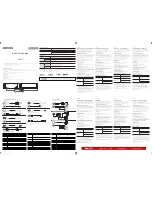
2.2.2
Ensure that the shaft is free of nicks or burrs and
the key fits properly in the shaft and gear.
2.2.3
Apply a light coat of anti-seizing compound
to the shaft and key. Tap the key into the shaft
keyway.
2.2.4
Heat the gear uniformly to 250
o
F (121
o
C)
to expand the bore and ease assembly. Press
the gear onto the shaft, making sure that the
dimension between the gear and the tensioner
mounting surface ("A") is m a i n tained. See
Figure 1 and Table 3. Allow the gear to cool.
2.2.5
Apply a thin coat of MOLUB-ALLOY
®
OG Heavy
- or equivalent - grease to the splines of the
gear. For Corrosion Resistant units, use
Molub-alloy
®
412 ES.
Excessive lubricant may contaminate
friction material, resulting in erratic
response or loss of torque.
The use of anti-seize or bearing greases
on the gear splines may result in prema-
ture gear and disc spline wear.
2.2.6
Pre-fill the grease channel in the friction disc
splines (if applicable) with MOLUB-ALLOY
®
OG
Heavy - or equivalent - grease, as shown on
Figure 4. Use 412 ES for Corrosion Resistant
units.
2.2.7
Rig the WCB2 into position and slide it over
the gear. Avoid placing lifting straps or cables
directly on the release springs (34).
2.2.8
Attach the mounting flange (1) to the mount-
ing surface using the appropriate fasten-
ers. If applied pressure was used to help
position the discs during mounting, exhaust the
air pressure prior to tightening the fasteners.
Tighten the fasteners to the specified torque
value. See Table 4.
Maximum allowable air pressure in the
cylinder (19) is 150psi (10.2 bar).
2.2.9
WCB2 tensioners should be covered to protect
the unit from dirt, rain, overspray, and other
sources of external contamination. In extreme
environments the use of a sealed enclosure with
internal strip heater is recommended to prevent
moisture from collecting on the unit.
2.3
Air System
Maximum allowable air pressure is
150PSIG (10.2bar). Application of
pressure exceeding maximum
allowable may result in damage
to the tensioner.
2.3.1
Maximum allowable pressure is 150 psi
(10.2 bar).
2.3.2
Use only clean, filtered air (a 50 micron filter
or better is recommended) which is free of
excess moisture.
2.3.3
Air inlet sizes are shown in Table 5. Air inlets
are located on the face of the cylinder (19). For
cylinders with three ports, the lowest port should
be located at or near the 6 o’clock position to
facilitate purging of moisture that may accumu-
late in the air system or cylinder.
Figure 4
TABLE 5
Air Inlet Size
Model
Thread Size
8WCB2
3/8"-18 NPT
14WCB2
1/2"-14 NPT
18WCB2
1/2"-14 NPT
24WCB2
1/2"-14 NPT
36WCB2
3/4"-14 NPT
48WCB2
1"-11.5 NPT
WCB 11070 VP 4.2 Format
8
© Copyright Eaton Corp., 2003. All rights reserved
April 2002 (Revised June 2003)










































